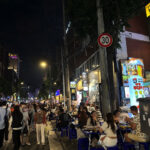Kalakaua Street, the famed thoroughfare in Honolulu, is more than just a road; it’s a vibrant tapestry woven with historical threads and modern-day dynamism. This iconic street has been welcoming visitors, including Hawaiian Royalty and dignitaries, since the 1800s, evolving from a simple stage service route to the bustling avenue we know today.
Originally known as Waikiki Road, its story began in 1868 with the introduction of a stage service, marking the early days of transportation in the area. As times changed, so did the mode of transport. 1888 saw the arrival of a horse-drawn tramcar system, paving the way for further modernization. By 1901, electric trolley service was established, solidifying Waikiki Road as a key artery. In 1908, the road underwent a significant transformation, being renamed Kalakaua Avenue in honor of King David Kalākaua, the last king of the Kingdom of Hawaii. King Kalākaua, who reigned from 1874 to 1891, was a celebrated monarch known for his deep appreciation of Hawaiian arts and traditions. His reign witnessed a resurgence of cultural practices like the beloved Hula dance, making the renaming a fitting tribute to his legacy.
The landscape around Kalakaua Street experienced a dramatic shift with the completion of the Ala Wai Canal in 1928. This engineering marvel played a pivotal role in reshaping the wetlands surrounding Waikiki into the thriving tourist hub it is today. By effectively managing stream runoff, the canal facilitated the development of Waikiki into the world-renowned destination it has become.
During World War II, following the 1941 attack on Pearl Harbor, Hawaii became a crucial military center. Kalakaua Street took on strategic importance as part of Hawaii Route 101 on a 1946 Army Map of O’ahu, serving as a vital link to military installations such as Fort DeRussy in Waikiki and Fort Ruger near Diamond Head Crater. These military routes were essential for navigation during wartime, marked with distinctive symbols like US Route-style shields.
However, the post-war era brought changes to the route designations. In 1955, the United States Bureau of Public Roads revamped the Hawaii Route System. While this renumbering established the two and three-digit system still largely in use, Kalakaua Street, despite its continued significance, did not receive a new designation or retain its previous one. Even without a formal route number, as evidenced by the 1959 Shell Highway Map of Hawaii, Kalakaua Street remained a prominent and indispensable thoroughfare in Waikiki.
Today, Kalakaua Street stands as a testament to Honolulu’s vibrant spirit. It’s a dynamic avenue brimming with an eclectic mix of shops, from luxury boutiques to local Hawaiian businesses, diverse restaurants offering global cuisines, and lively entertainment venues. This iconic street provides an engaging blend of authentic Hawaiian culture and contemporary urban experiences, captivating both visitors and residents alike with its energetic atmosphere and stunning views of the famous Waikiki Beach. Kalakaua Street truly embodies the beating heart of Honolulu, a place where history and modernity seamlessly intertwine.

